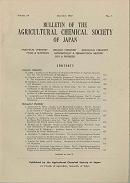Volume 23, Issue 6
Displaying 1-21 of 21 articles from this issue
- |<
- <
- 1
- >
- >|
-
1959Volume 23Issue 6 Pages 457-459
Published: 1959
Released on J-STAGE: November 27, 2008
Download PDF (145K) -
1959Volume 23Issue 6 Pages 460-464
Published: 1959
Released on J-STAGE: November 27, 2008
Download PDF (1802K) -
1959Volume 23Issue 6 Pages 465-474
Published: 1959
Released on J-STAGE: November 27, 2008
Download PDF (644K) -
1959Volume 23Issue 6 Pages 475-481
Published: 1959
Released on J-STAGE: November 27, 2008
Download PDF (430K) -
1959Volume 23Issue 6 Pages 482-489
Published: 1959
Released on J-STAGE: November 27, 2008
Download PDF (539K) -
1959Volume 23Issue 6 Pages 489-492
Published: 1959
Released on J-STAGE: November 27, 2008
Download PDF (292K) -
1959Volume 23Issue 6 Pages 493-498
Published: 1959
Released on J-STAGE: November 27, 2008
Download PDF (354K) -
1959Volume 23Issue 6 Pages 499-509
Published: 1959
Released on J-STAGE: November 27, 2008
Download PDF (671K) -
1959Volume 23Issue 6 Pages 509-524
Published: 1959
Released on J-STAGE: November 27, 2008
Download PDF (926K) -
1959Volume 23Issue 6 Pages 524-527
Published: 1959
Released on J-STAGE: November 27, 2008
Download PDF (256K) -
1959Volume 23Issue 6 Pages 528-532
Published: 1959
Released on J-STAGE: November 27, 2008
Download PDF (354K) -
1959Volume 23Issue 6 Pages 532-535
Published: 1959
Released on J-STAGE: November 27, 2008
Download PDF (223K) -
1959Volume 23Issue 6 Pages 536-547
Published: 1959
Released on J-STAGE: November 27, 2008
Download PDF (799K) -
1959Volume 23Issue 6 Pages 547-551
Published: 1959
Released on J-STAGE: November 27, 2008
Download PDF (314K) -
1959Volume 23Issue 6 Pages 551-554
Published: 1959
Released on J-STAGE: November 27, 2008
Download PDF (288K) -
1959Volume 23Issue 6 Pages 555-556
Published: 1959
Released on J-STAGE: November 27, 2008
Download PDF (158K) -
1959Volume 23Issue 6 Pages 556-557
Published: 1959
Released on J-STAGE: November 27, 2008
Download PDF (830K) -
1959Volume 23Issue 6 Pages 558-559
Published: 1959
Released on J-STAGE: November 27, 2008
Download PDF (107K) -
1959Volume 23Issue 6 Pages e2a
Published: 1959
Released on J-STAGE: November 27, 2008
Download PDF (13K) -
1959Volume 23Issue 6 Pages e2b
Published: 1959
Released on J-STAGE: November 27, 2008
Download PDF (13K) -
1959Volume 23Issue 6 Pages e2c
Published: 1959
Released on J-STAGE: November 27, 2008
Download PDF (13K)
- |<
- <
- 1
- >
- >|
